Manuscripts Etc.
| CLOSE WINDOW |

|
The following items are drawn from the William Faulkner Foundation Collection at the University of Virginia's Albert and Shirley Small Special Collections Library (http://small.library.virginia.edu/). |
|
The manuscript and typescript of this long novel make two very thick stacks of paper. In several ways they allow us to look over Faulkner's shoulder as he found the best way to tell his story. According to the date on the manuscript's title page (below left), he began writing it on "17 August 1931" under the title "Dark House." Sometime in that month, however, after being inspired by a remark made by his wife Estelle, he boldly crossed out that title and replaced it with "Light in August." There have been several different interpretations of that final choice (see, or rather listen to, the first "AudioClip" for the novel). But it's also interesting to think about how writing — and reading — the novel might have been different if he'd stuck with that original title. Which house, for example, is the dark house? Six months later, with Lena Grove's journey taking him beyond the bottom of the page, Faulkner wrote "19 Feb 1932" on the last page of the manuscript (below right):
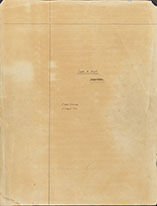  Note the difference in color between the two sheets of paper above. One reason the manuscript makes such an impressive stack is that many of its pages are two sheets thick. The first three pages below, for example, are pages 21, 20 and 19 of the manuscript, describing the first time Lena and Byron meet. By viewing them in this reverse order, you can see how Faulkner built the manuscript we have partly with passages cut from an earlier one and pasted onto new, darker colored sheets of paper, and also see how one of the novel's most conspicuous stylistic signatures, its narrative use of both the past and present tenses, was a secondary revision. Page 21 (below left) consists almost entirely of two separate passages from that earlier manuscript (note their lighter color). The events in those passages were originally narrated in the conventional novelistic past tense; in revision Faulkner shifts all the verbs to the present tense — "continued" becomes "continues," and so on. Page 20 (below left center) makes it clear that these revisions were made when he began the newer manuscript: the "says" that replaces the original "said" was written on the darker sheet after Faulkner pasted the passages onto it. Page 19 of the manuscript and its corresponding typescript page show how Faulkner continued to revise the text, finding new uses for the technique of changing tenses. Page 19 (below right center) was entirely written on a new page, but despite this Faulkner still uses the past tense to describe the moment when Bryon "fell in love" with Lena. When still later, before sending the novel to the publisher, he typed this passage out (below far right), he made a very significant change: following up the phrase "fell in love" with a new one in the present tense — "It happens . . ." Among the novel's major characters, Lena from the start and Bryon from this moment on are the only two who can live in the present. As that "monumental" column of smoke that looms over the scene in both the manuscript and the typescript reminds us, Joe and Joanna, like Hightower, the Hineses and the people of Jefferson, are unable to escape the hold of the past. At the moment that love "happens" to Bryon, however, he explicitly transcends his own "austere and jealous" conditioning. Like the past, love brings its own obligations into his life, but it also enables him to move toward a new future as he leaves Yoknapatawpha behind. 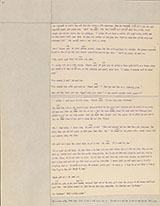 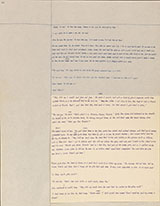 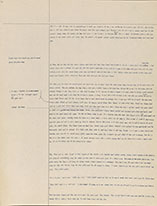 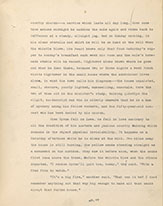 We can't know what was on the pages of that earlier manuscript that Faulkner didn't salvage. But there is more the extant pages can show us about how Faulkner continued to explore alternative ways to tell his story. Here the most telling evidence can be found at the edges of the pages. Like his earlier manuscripts, Light in August was written first in longhand on blank sheets of sturdy paper, though for this novel Faulkner decided to draw a pair of lines on each sheet, dividing the surface into four asymmetrical sections. The small box at the top left was reserved for a page's number. Many of the pages in the manuscript of Light in August have multiple numbers, often as many as eight — Faulkner shifted around page 59 (below left) six times, to various places between page 39 and page 72, before deciding on its ultimate place. This passage was also the beginning of five different chapters (one twice) before Faulkner settled on chapter "VII." Page 108 (below left center) records similar kinds of reorganizing, and adds a detail that suggests the consequences for Faulkner himself of all the re-ordering he was doing. In his handmade top right-hand box, he has written what has to be read as a note to himself, tersely summing up what is happening at this point in the manuscript. The 187-page manuscript includes two other such summaries: the boxes at the top of pages 24 and 110 (below right) also display this atypical kind of "bookkeeping." 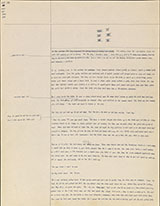 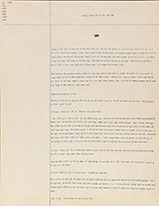 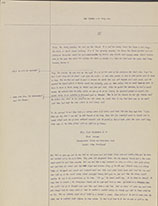 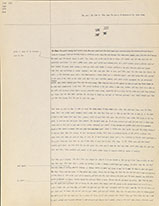 The evidence of the manuscript suggests that as Faulkner wrote this version, the pieces of his story did fall into their ultimate places: beginning with page 140 (the second page of Chapter XVI) only two sheets have more one page number (146 became 147, and 182, 184), and only one chapter was re-numbered (XIX was originally XVII). But as already noted, the process of revising continued as he typed his handwritten manuscript. For example, when he got to the last page of chapter III in the typescript (below left), he briefly considered adding a suggestion of slapstick to the narrative, interpolating some "banana peals skins" into a passage about human frailty before cancelling them with the front slashes (///) he invariably used to cross words out with his typewriter. Two sets of stylistic changes on the typescript were not made by the author. The other typescripts in the Faulkner Foundation Collection are the "carbon" copies that he kept when he sent the "ribbon typescripts" of his work to publishers, but the typescript of Light in August is the "setting copy" that has been prepared for the printer by a copy editor at Smith and Haas. As you can see from page 290 (below right), that editor regularized Faulkner's punctuation, replacing his idiosyncratic ". . . . . . . ." with conventional ellipses (". . ."). Faulkner's use of the hyphen was also regularized wherever it appeared, so that his long dashes ("---") and even longer dashes ("--------") were replaced with the conventional "1 em" (--). "The Corrected Text" of the novel that Noel Polk created in 1985 restores Faulkner's original punctuation.
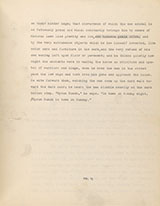 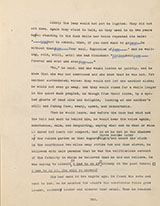 Citing this source: |
